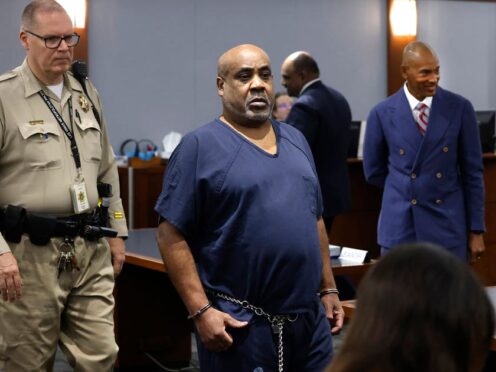The defence lawyer representing a former Los Angeles gang leader accused of killing hip-hop music star Tupac Shakur in 1996 in Las Vegas has said his client’s accounts of the killing are fiction and prosecutors lack key evidence to obtain a murder conviction.
“He himself is giving different stories,” lawyer Carl Arnold told reporters outside a courtroom following a brief status check with his client, Duane “Keffe D” Davis, in front of a Nevada judge. His trial is scheduled for November 4.
“We haven’t seen more than just his word,” Mr Arnold said of Davis’s police and media interviews since 2008 in which prosecutors say he incriminated himself in Shakur’s killing — including Davis’s 2019 tell-all memoir of life leading a street gang in Compton, California.
Prosecutor Binu Palal did not immediately comment outside court about Mr Arnold’s statements. Clark County district attorney Steve Wolfson has said evidence against Davis is strong and it will be up to a jury to decide the credibility of Davis’s accounts.

Mr Arnold said his client wanted to make money with his story, so he embellished or outright lied about his involvement in the car-to-car shooting that killed Shakur and wounded rap music mogul Marion “Suge” Knight at a traffic signal near the Las Vegas Strip in September 1996.
Knight, now 59, is serving 28 years in a California prison for killing a Compton businessman with a vehicle in 2015. He was not called by prosecutors to give evidence before the grand jury that indicted Davis last year.
Mr Arnold said Davis will not give evidence at trial, but he intends to call Knight to testify. The defence lawyer said police and prosecutors lack proof that Davis was in Las Vegas at the time of Shakur’s killing, and do not have the gun and car used during the shooting as evidence.
“We’ve seen video of everybody else here. Where’s video of him?” Mr Arnold said of Davis. “There’s just nothing saying that he was here.”
Davis has been jailed on 750,000-dollar (£600,000) bail since his arrest in September. Mr Arnold said on Tuesday that Davis has been unable to raise the 10% needed to obtain a bond to be released to house arrest.
Davis, 60, is originally from Compton. Police, prosecutors and Davis say he is the only person still alive who was in the car from which shots were fired.
Davis pleaded not guilty in November to first-degree murder. If convicted, he could spend the rest of his life in prison.
In his book, Davis wrote that he was promised immunity from prosecution when he told authorities in Los Angeles what he knew about the fatal shootings of Shakur and rival rapper Christopher Wallace six months later in Los Angeles. Wallace was known as The Notorious B.I.G. or Biggie Smalls.
Shakur had five number one albums, was nominated for six Grammy Awards and was inducted in 2017 into the Rock & Roll Hall of Fame. He received a posthumous star last year on the Hollywood Walk of Fame.
